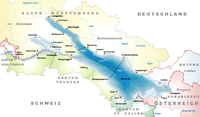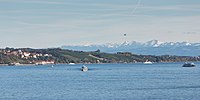
The Rhine is one of the major European rivers. The river begins in the Swiss canton of Graubünden in the southeastern Swiss Alps. It forms part of the Swiss-Liechtenstein border, then part of the Swiss-Austrian border. From Lake Constance downstream, it forms part of the Swiss-German border. After that the Rhine defines much of the Franco-German border. It then flows in a mostly northerly direction through the German Rhineland. Finally in Germany, the Rhine turns into a predominantly westerly direction and flows into the Netherlands where it eventually empties into the North Sea. It drains an area of 9,973 km2.
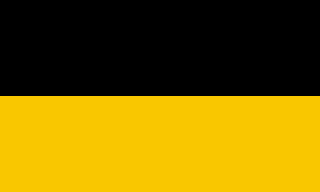
Baden-Württemberg, commonly shortened to BW or BaWü, is a German state in Southwest Germany, east of the Rhine, which forms the southern part of Germany's western border with France. With more than 11.07 million inhabitants as of 2019 across a total area of nearly 35,752 km2 (13,804 sq mi), it is the third-largest German state by both area and population. As a federated state, Baden-Württemberg is a partly-sovereign parliamentary republic. The largest city in Baden-Württemberg is the state capital of Stuttgart, followed by Mannheim and Karlsruhe. Other major cities are Freiburg im Breisgau, Heidelberg, Heilbronn, Pforzheim, Reutlingen, Tübingen, and Ulm.

Lake Constance refers to three bodies of water on the Rhine at the northern foot of the Alps: Upper Lake Constance (Obersee), Lower Lake Constance (Untersee), and a connecting stretch of the Rhine, called the Seerhein. These waterbodies lie within the Lake Constance Basin in the Alpine Foreland through which the Rhine flows. The nearby Mindelsee is not considered part of Lake Constance. The lake is situated where Germany, Switzerland, and Austria meet. Its shorelines lie in the German states of Baden-Württemberg and Bavaria; the Swiss cantons of St. Gallen, Thurgau, and Schaffhausen; and the Austrian state of Vorarlberg. The actual locations of the country borders within the lake are disputed.
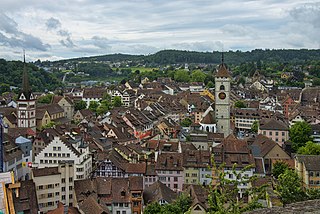
Schaffhausen, historically known in English as Shaffhouse, is a town with historic roots, a municipality in northern Switzerland, and the capital of the canton of the same name; it has an estimated population of 36,000 as of December 2016. It is located right next to the shore of the High Rhine; it is one of four Swiss towns located on the northern side of the Rhine, along with Neuhausen am Rheinfall, the historic Neunkirch, and medieval Stein am Rhein.

The canton of Schaffhausen, also canton of Schaffhouse, is the northernmost canton of Switzerland. The principal city and capital of the canton is Schaffhausen. The canton's territory is divided into three non-contiguous segments, where German territory reaches the Rhine. The large central part, which includes the capital, in turn separates the German exclave of Büsingen am Hochrhein from the rest of Germany.

"Die Wacht am Rhein" is a German patriotic anthem. The song's origins are rooted in the historical French–German enmity, and it was particularly popular in Germany during the Franco-Prussian War, World War I, and World War II. The original poem was written by Max Schneckenburger during the Rhine crisis of 1840, and is generally sung to music written by Karl Wilhelm in 1854, seven years after Schneckenburger's death.
Stein am Rhein is a historic town and a municipality in the canton of Schaffhausen in Switzerland.

Bingen am Rhein is a town in the Mainz-Bingen district in Rhineland-Palatinate, Germany.
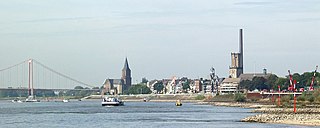
Emmerich am Rhein is a city and municipality in the northwest of the German federal state of North Rhine-Westphalia. The city has a harbour and a quay at the Rhine. In terms of local government organization, it is a medium-sized city belonging to the district of Kleve in the administrative region (Regierungsbezirk) of Düsseldorf.

The Rhine Gorge is a popular name for the Upper Middle Rhine Valley, a 65 km (40 mi) section of the Rhine between Koblenz and Rüdesheim in the states of Rhineland-Palatinate and Hesse in Germany. It was added to the UNESCO list of World Heritage Sites in June 2002 because of its beauty as a cultural landscape, its importance as a route of transport across Europe, and the unique adaptations of the buildings and terraces to the steep slopes of the gorge.

Blankenstein Castle is a castle located on the south side of the river Ruhr in Hattingen, North Rhine-Westphalia, Germany.

High Rhine is the name of the part of the Rhine between Lake Constance and the city of Basel, flowing in a general east-to-west direction and forming mostly the Germany–Switzerland border. It is the first of four named sections of the Rhine between Lake Constance and the river delta at the North Sea.

Hemishofen is a municipality in the canton of Schaffhausen in Switzerland.

Ramsen is a municipality in the canton of Schaffhausen in northern Switzerland.

The Lake Line, as it is referred to by the SBB in English, is the Swiss railway line running from Rorschach via Romanshorn, Konstanz (Germany), Kreuzlingen, Steckborn, Stein am Rhein and Diessenhofen to Schaffhausen. The scenic route follows the southern border of Lake Constance and the High Rhine. It forms the Swiss section of the ring railway around Lake Constance.
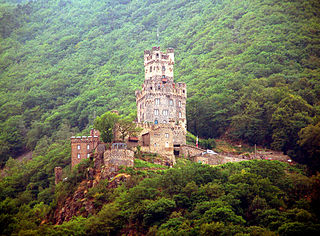
Sooneck Castle is a castle in the upper middle valley of the Rhine, in the Mainz-Bingen district of Rhineland-Palatinate, Germany. It is located near the village of Niederheimbach between Bingen and Bacharach.
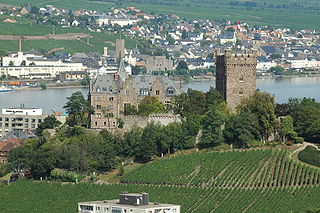
Klopp Castle is a castle in the town of Bingen am Rhein in the Upper Middle Rhine Valley in Rhineland-Palatinate, Germany. In the nineteenth century, the bergfried from the original medieval fortified castle was restored and a new building added which houses the town's administration.

The Untersee, also known as Lower Lake Constance, is the smaller of the two lakes that together form Lake Constance. The boundary between Switzerland and Germany runs through it. The lake surrounds several islands, the largest being Reichenau Island.

Schaffhausen railway station is a railway station in Schaffhausen, the capital of the Swiss canton of Schaffhausen. The station is jointly owned by the Swiss Federal Railways (SBB CFF FFS) and Deutsche Bahn (DB), and is served by trains of both national operators, as well as trains of the Swiss regional operator Thurbo.

The border between the modern states of Germany and Switzerland extends to 362 kilometres (225 mi), mostly following Lake Constance and the High Rhine, with territories to the north mostly belonging to Germany and territories to the south mainly to Switzerland. Exceptions are the Swiss canton of Schaffhausen, the Rafzerfeld and hamlet of Nohl of the canton of Zürich, Bettingen and Riehen municipalities and part of the city of Basel in the canton of Basel-City and the old town of the German city of Konstanz, which is located south of the Seerhein. The canton of Schaffhausen is located almost entirely on the northern side of the High Rhine, with the exception of the southern part of the municipality of Stein am Rhein. The German municipality of Büsingen am Hochrhein is an enclave surrounded by Swiss territory.























